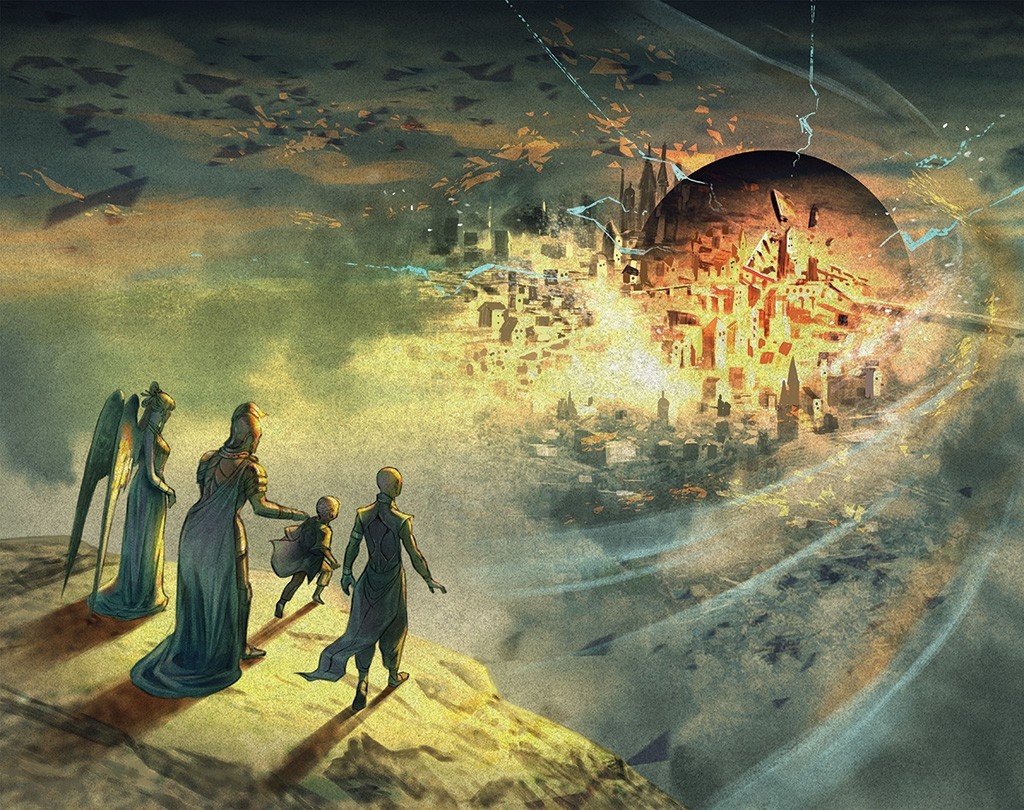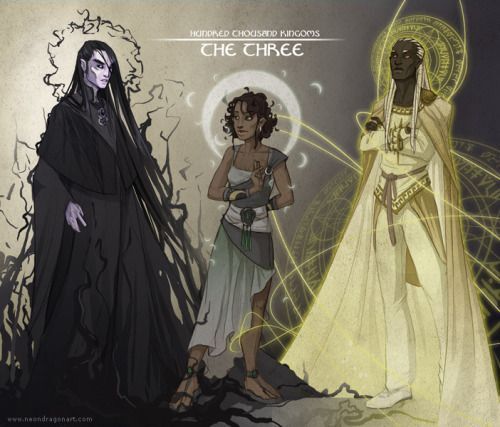N.K. Jemisin brings many tools to her world-building, especially a focus on how power is distributed and contested by the clans of her peoples. The manifestation of power is evident throughout The Hundred Thousand Kingdoms, but one illustration in particular is the division of nobles in the Consortium. Yeine comments on the inequity of their distribution, citing as an example that the city of Sky (including the palace) has one delegate, whereas the entirety of the High North continent has only two. A delegate’s task is “to speak for themselves and their neighboring lands,” but one fundamental question is whether the needs of these conquered nations can be accurately expressed in the only language of the Consortium: Senmite, the language of the Amn that “the Arameri had imposed… on the world” (ch 6).
Jemisin mentions a number of peoples and languages in this first book of The Inheritance Trilogy including Nirva (a common tongue of the High North), the aforementioned Senmite, Teman, Kenti, Darren, and Mencheyev. It is unclear whether other peoples mentioned (like the Min, Ghor, Uthre, or Irti—these last two are related to the Ken) have their own languages. There is a parallel between Darr and the Amn, in that both peoples conquered other tribes; however, while the Amn forced Senmite on the vanquished foes, Darr did not. The common language of the north is not Darren, but Nirva. The characterization of language as an ethnic weapon
From a world-building perspective, what is most remarkable to me is how Jemisin crafts such a rich universe from sparse material. Jemisin collected her development notes in a Non-Wiki (see links below), which includes descriptions of characters (WARNING: There are spoilers for books 2 & 3), races, and locations, along with a timeline (under “Miscellany.”) Darre and Amn have adequate descriptions, but most mortal races garner only a few sentences. The nation of Tokland has seven words. The listing for Uthre and Irti only mention the “peaceful annexation.” In her conception of this universe, Jemisin’s efficiency reveals her storytelling’s reals foci are the interactions of the gods and how they affect mortals.
Mortals appropriate the language of the gods to cast spells that change reality in small ways. The specialists in this field are called scriveners, represented in The Hundred Thousand Kingdoms by the character Viraine (who is secretly also Ytempas, the inventor of language). The divine language “allows the conceptualization of the impossible,” and scriveners learn several mortal tongues first as children to “help[] them understand the flexibility of language and of the mind itself” (ch. 11). The dependency between reality and language is reminiscent of work by linguist Ferdinand de Saussure, who developed a discourse for the relationship between names and objects, and literary theorist Roland Barthes, who proposes that the “signifier comes before the signified,” that in essence all the signified “is socially constructed by its circulation between the user and the consumer of the sign,” and that, therefore, “language determines the order of the world, not the other way around” (Finnison 71). Seen this way, the magic of Jemisin’s god language might be seen as a concretization of abstract concepts, a reification, and the exchange of one reality for another relies on the mere acceptance of the believer.
At the end of the novel, the (Yeine/Enefa as I) narrator disabuses us of the necessity of language in this equation. While the magical transformation of reality “may be approximate[d]… through the use [by mortals] of the gods’ language”, Nahadoth and Yeine do not require such crude artifices (glossary entry: “Magic”). In the confrontation with Ytempas, the narrator discloses that “Language had been his invention; we had never really needed words” (ch 29). Nahadoth then reshapes reality itself, and then there is an apparent contradiction, for it is stated “we had never really needed a separate language, either; any tongue would do, as long as one of us spoke the words,” which seems to counter the notion that “we had never really needed words;” however, language and words are not equivalent. It is confusing though.
What is not confusing, however, is how Jemisin uses stammering in the novel to depict the breadth of the gap of power. Three characters stutter: Nahadoth (when recovering from pain), T’vril (while making a clumsy attempt at seduction), and (most prominently) Yeine, who stammers (both in her language and Senmite) eight times: “S-top!” (ch 5), “P-poison?” (ch 10), “A-all that surprises me are… the lies I’ve been told” (ch 10), (N-no) (ch 10), “Y-you are welcome in my family’s home” (ch 16), “N-nothing” (ch 17, when T’vril is about to offer sex between friends), “H-he could…” (ch 18), and above all, “R-Relad” in chapter 27. The stammer softens a warrior character who is impulsive and direct, but it also reveals the stress that her lack of power imposes upon her. Jemisin’s use of stammer attunes the reader to perceive Yeine as weaker before the gods, even though (as we later learn) she is a vessel for one of the universe’s most powerful vehicles.
Anyway, it is very interesting to see how Jemisin uses language to reflect upon the distribution of power.
Works Cited:
Finnison, Ari. “‘Language on Holiday:’ Wittgenstein and the Language-Reality Gap in Historical Narratives.” The Corvette. Volume 5. Spring 2018. University of Victoria. Undergraduate History Journal. https://journals.uvic.ca/index.php/corvette/article/view/19007
Jemisin, N.K. The Hundred Thousand Kingdoms. Orbit Books. 2010.
Jemisin, N.K. The Inheritance Trilogy Non-Wiki. http://nkjemisin.com/the-inheritance-trilogy-non-wiki/
Note: I intentionally left out the use of the imperative in the Arameri commands of the Enefadah, because I wish to address this as part of my second essay about power and slavery.

